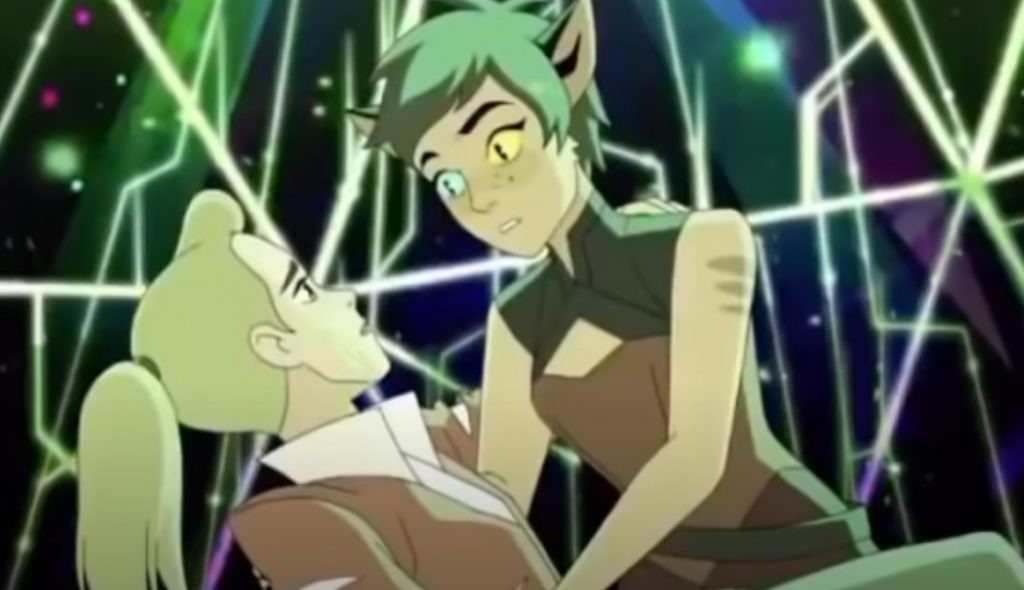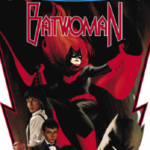The 2020-2021 GLAAD TV Report Reveals Worsening Trends

It’s the 25th year GLAAD has tracked LGBTQ+ TV characters and the 16th ‘Where We Are on TV‘ study, and things are looking a bit bleak this year.
The GLAAD study notes that only 9.1% of the scripted characters scheduled to appear in the 2020-2021 year identify as LGBTQ+ whereas the 2019-2020 season has 10.1%. This is the first major drop since the 2013-2014 report. In a year where many people are seeking comfort through fandom and media consumption – many of which are LGBTQ+ individuals who may be isolated from their communities or stuck in households that are less accepting of their sexuality or gender expression – this is an unfortunate trend downward.
Unfortunately, the pandemic may be the cause of this decrease due to delayed production and cancelled shows, so the very thing that’s causing our stress might also be taking away something that can help us get through it.
But at the same time, if you look at it from a quality perspective instead of a quantity perspective, we did manage to get some fantastic representation regardless of this worsening trend. With both Schitt’s Creek and She-Ra and the Princess of Power receiving high acclaim and great ratings, it feels like there is at the very least an increase in quality and popularity.
The argument can be made that quality is better than quantity, but when you get down to it, both are important in order to show the breadth and diversity of the LGBTQ+ experience. When the onus falls on just a handful of characters to represent that experience, as quality as those characters may be, it can add pressure to those shows to get everything perfect. One misstep with these characters can feel like a punch to the gut for the community, whereas a larger quantity for us to choose from lessons the impact of one single misstep.
Let’s break down the study and see where we’re at on TV across broadcast TV, cable, and streaming services.
Broadcast Television
Here’s a basic outline of stats for broadcast TV:
This year’s Where We Are On TV study found that of the 773 series regular characters scheduled to appear on broadcast scripted primetime television this season, 70 (9.1 percent) are LGBTQ. This is a decrease from the previous year’s record high percentage of 10.2 percent, and the first season to mark a decrease in this percentage since it last fell in the 2013-14 report. This percentage was expected to show a temporary decrease due to the COVID-19 pandemic halting production on several shows and impacting development of new series. There are an additional 31 LGBTQ recurring characters on broadcast, for a total of 101 LGBTQ characters, down from last year’s 120. There was also a significant decrease in overall primetime scripted broadcast series – down to 96 series from the previous year’s 111 which fell within GLAAD’s methodology.
While a decrease overall was expected due to the pandemic, it’s interesting to note why the percentage itself may have decreased in comparison to other shows. We lost Schitt’s Creek, How to Get Away with Murder and Stumptown, which took several LGBTQ+ characters with them, but there was simply nothing to fill the gap those shows left behind. The study notes that keeping people safe while filming during the pandemic could cost between $150,000-300,000 per show. This means that a new and untested show that could have had some LGBTQ+ characters in them never made it to production. I don’t know which shows would have filled the gap, but there are a lot of shows that were cancelled before filming due to the pandemic.
The community hardest hit by this drop are bisexual characters, which dropped 11% from 2019-2020 to 2020-2021. There are just 18 bisexual characters, representing an 18% share when it comes to the LGBTQ+ characters on television, whereas this group actually makes up about 52% of the community here in the real world overall, according to the GLAAD report. While they make up a huge chunk of our real-world community, their onscreen representation is extremely low and going lower year after year. Bisexuals deserve some more representation than what they’re getting.
There’s a surprise win for the transgender community, however, as on-screen representation rose from seven to ten characters. This is made up of four trans men and six trans women. Broadcast television also has two non-binary characters (currently under embargo), which GLAAD traditionally categorized under the trans umbrella. They are shifting how they are categorizing this, however, and will only classify non-binary characters as trans if they explicitly state that they belong to this group.
GLAAD has clarified this new distinction in their reports:
Historically, GLAAD has counted all non-binary characters as also being transgender characters. However, starting this year, in recognition of the changing definition of the word non-binary, we will only count a non-binary character as transgender if the creators confirmed the character to be trans and/or a trans identity is explicitly discussed or portrayed onscreen. If the character is non-binary, but the word transgender is never mentioned, the character explicitly says they are not transgender, or creators confirm the character is not transgender – the character will be counted as non-binary but not counted as transgender in the tally of trans characters on TV.
While the number for transgender and non-binary characters are still fairly low, it’s still good to see this trend upward despite the general downward trend this year for the LGBTQ+ community overall. I only hope that this trend continues, especially when the entertainment industry bounces back.
Cable Television
This year’s study found primetime scripted cable to be the platform with the most significant decrease in LGBTQ representation year over year. On scripted primetime cable series, the number of LGBTQ series regulars has decreased from 121 to 81 characters, with 37 recurring LGBTQ characters from 94, bringing the total number of LGBTQ characters down to 118 from 215. Several LGBTQ-inclusive cable series are anticipated to return in next year’s edition after COVID-19 production shutdowns forced delays which kept series from being confirmed to air within this report’s research period, including The L Word: Generation Q, Euphoria, Killing Eve and more. For the first time in the report’s history, over half of LGBTQ characters on primetime scripted cable are people of color, meeting and surpassing GLAAD’s challenge from last year’s report for each platform to ensure that within two years at least half of LGBTQ characters tracked on each platform are people of color. Prior to this year, only broadcast had achieved this goal.
Cable TV, often viewed as having much more freedom in regards to content, had the largest drop of any of the platforms overall at about 55%. However, the report from GLAAD notes that, while this drop is significant, most of these shows are scheduled to come back at a later date and are only facing filming challenges due to the ongoing pandemic. Unlike network television, cable hasn’t taken an ax to these shows and has merely pushed them back a bit. These delayed shows include Euphoria, Gentleman Jack, The L Word: Generation Q, and Killing Eve. The biggest victim of these delayed shows are bisexual and lesbian women, who have seen a drop of over 57 characters, which should be pretty clear from this list of delayed shows.
However, cable did meet the challenge that GLAAD threw down about having at least half of all LGBTQ+ characters be people of color within the next two years. Broadcast TV had met that goal already, and within one year cable rose to the challenge as well with 52% meeting this criteria. Black and multiracial groups saw a particularly notable bump, but unfortunately, Latinx and API characters saw a decrease. Overall, there were more POC, but not every group within this community benefitted from this increase.
Cable also has 8 LGBTQ+ characters with disabilities, which is a group that is consistently under-represented across the board. This is a nuanced group that should be handled with care and respect, but is sadly overlooked much of the time. This lack of representation also extends outside the LGBTQ+ community overall, and is something all platforms really need to work on.
There are no asexual characters slated for the season at all, which, as an asexual, is extremely disappointing. At this point, I’m used to having basically nothing canon, but I’d very much like to see that change in my lifetime.
Streaming Services
On the streaming services Amazon, Hulu, and Netflix, there are 95 regular LGBTQ characters featured on original scripted series, a decrease from last year, as well as 46 LGBTQ recurring characters. This brings the total to 141 LGBTQ characters, a decrease of 12 from last year’s report. Streaming was the only platform where white LGBTQ characters outnumber LGBTQ characters of color, though racial diversity of LGBTQ characters on streaming did improve by six percentage points to 46 percent of LGBTQ characters also being people of color. Across all streaming television, there was one LGBTQ character confirmed with a disability: Ryan Hayes (Ryan O’Connell) from Netflix’s Special. For the fourth year in a row, lesbian representation decreased on streaming, to 28 percent of LGBTQ characters.
Streaming services were the least impacted by the overall decrease, but still saw a slight decrease. I assume this is largely due to how far in advance streaming services tend to film their shows. I have a friend who does editing work for Netflix, and her work hasn’t slowed down at all during the pandemic. They’ve got a good backlog of content to release to us so they weren’t impacted by the pandemic-related problems plaguing other platforms. But does this mean the lag will catch up with it in the 2021-2022 report? I’m not entirely sure. But let’s look at this year and cross that bridge when we come to it.
Unfortunately, lesbian representation saw the biggest decrease. Their representation is down 2% and this marks the fourth year that this particular group has seen a decrease on this platform. And, in a reversal of broadcasting networks, transgender representation on streaming services has seen a decrease as well. There are only nine trans characters: four trans women, five trans men, and zero non-binary characters identifying as trans or otherwise.

However, while bisexual characters suffered the hardest on network TV, they actually increased to 19% of the total LGBTQ+ characters, with bisexual men being the most notable increase among them. This is still less than the 52% of the LGBTQ+ community that identifies as bisexual, but it’s a step in the right direction. Bisexual men have often been overlooked in media, so I’m happy to see this, even if it’s a small number overall. We have to start somewhere! More bisexual men, please!
There is only one asexual character slated for the 2020-2021 season. The report describes the character as an asexual lesbian and she’s expected to be on Freeform, but the details around this character are currently under embargo. This is the only asexual character across all three platforms so I’ll definitely be tuning in to see how it works out once I find out which show such a character is on. I’m also interested in the description ‘asexual lesbian,’ and look forward to how more nuanced terminology is portrayed. I’ll be curious to see if this is a sort of demi-sexuality, or perhaps if they’ll be depicting a character whose romantic orientation and sexual orientation differ. Or maybe it’s something else? I’m not sure! But I look forward to it.
Streaming services have almost met the LGBTQ+ POC challenge with 47% of their representation overall. It still lags behind broadcasting and cable, but it’s getting very close. GLAAD had this to say about this lag in representation:
Streaming is lagging behind the other platforms regarding its representation of marginalized groups within the community. This year, streaming is the only platform where the majority of LGBTQ characters are white, the platform counts the fewest number of transgender characters of all platforms tracked (broadcast, cable, streaming) plus a year-over-year decrease, and there is only one LGBTQ character on scripted streaming originals who is confirmed as also being a person with a disability (Ryan, Netflix’s Special). These are areas of opportunity and growth for streaming platforms. Additionally, we’d further like to see a streaming service premiere a new series with a majority LGBTQ cast as none have premiered since the miniseries Tales of the City. While Netflix in 2019 announced an animated series called Q-Force about a group of queer heroes, no date has yet been given and there has not been further public news announced. We look forward to what is to come.
Streaming only has one LGBTQ+ character with a disability, but it happens to be the lead character of the show Special. I haven’t seen the show so I can’t make any determination on how good this representation is, but the actor who plays the lead is both an LGBTQ+ activist and a disability activist, so that gives me hope for some care with the representation. It also has pretty high ratings on aggregator sites. But as I haven’t seen it, I’m not sure! If you’ve seen it, please let me know your thoughts.
–
Overall, we have a long way to go for many demographics, including asexual, non-binary, and disabled characters. The other trends tend to change depending on what platform you choose, but have overall trended downward due to pandemic complications.
Let’s try to enjoy what we do manage to get in these troubling times, but keep holding media accountable as we go forward. When the entertainment industry bounces back, let’s hope it bounces back stronger than ever.
Author: Angel Wilson
Angel is the admin of The Geekiary and a geek culture commentator. They earned a BA in Film & Digital Media from UC Santa Cruz. They have contributed to various podcasts and webcasts including An Englishman in San Diego, Free to Be Radio, and Genre TV for All. They identify as queer.
Help support independent journalism. Subscribe to our Patreon.
Copyright © The Geekiary
Do not copy our content in whole to other websites. If you are reading this anywhere besides TheGeekiary.com, it has been stolen.Read our







2 thoughts on “The 2020-2021 GLAAD TV Report Reveals Worsening Trends”
Comments are closed.